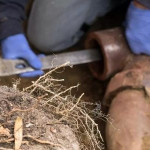How Your Garden Can Affect Your Plumbing
Spring is a time when many people begin to think about landscaping. Choosing the right soil for healthy plants is a common concern, but it's not the only one that affects a home. The landscape of a property can impact the overall plumbing system.
Branching Out
One can find a house's plumbing system deep underground the property. This sewer line is designed to help clear out wastewater to keep tap water fresh and remove contaminants. Since these lines contain water, the ground is subsequently affected.
Cracks and pipe damage can occur from what is known as root intrusion. This happens when tree roots cause breakage at one of the pipe joints. Once the roots have made their way into the water system, they access various nutrients and oxygen. While this is great for the trees, this is terrible news for the sewer line.
Compromised sewer lines make it difficult for sewage to flow into the main pipe system. This frequently causes back-ups in home areas like the garage or basement. It is best to locate the sewer line before planting large trees that may "wander."
Intruding Roots Cause Destruction
There are a few unpleasant side effects to root intrusion. Water pressure and draining issues are among the most commonly noted.
Roots will clog the pipeline once they have made their way inside. The hair-like root structure begins to form around each vulnerable point in the pipe. This effectively blocks off the entryway while it creates its net. Debris such as hair then builds up, causing reduced drainage in sinks and bathtubs.
If the roots expand, they can create a complete blockage in the drain. With the added pressure of plant growth, cracks in the pipe are likely to occur at the entry point. A burst pipe can break due to root pressure.
One of the ways to tell if a plumbing system is impacted by plant growth is to test the water pressure. A reduced water flow is often most noticeable in the shower. Lower water pressure combined with high electric bills indicates that faulty plumbing is to blame.
Water leaks happen when pipes have been compromised from pressure or outside damage. If tree roots cause a water leak, this can damage the inside of a house. Underground leaks are known to cause dirty water and floor damage.
 How To Deal With Root Obstruction
How To Deal With Root Obstruction
Root obstruction is a problem that requires experience and equipment. Because the sewer line is underground, this job is difficult for most people to maneuver. Once underground, the issue of removal is also complex.
Homemade root-killing remedies are available, but the chemicals may be difficult to find. Copper sulfate and rock salt may help kill roots, but this is unlikely if the root intrusion has already formed a mass.
Professional plumbers will often diagnose the problem using a specialized camera designed for underground pipe inspection. Line cameras can locate tree roots and cracks, clogs, and leaks.
Once the plant life has been identified, an attached cable feeds a mechanical auger into the sewer. The blades at the end of the auger will cut the roots, making them easy to flush out of the sewer line.
There are a few ways to clear a sewer line depending on the severity of root intrusion. Hydro-jetting is typically tried first. This process involves using high-pressure water to flood the clog. This can also get rid of other damaging materials such as grease.
Hydro-jetting is more powerful than using a plumbing snake but may not be strong enough to break up tough roots. Inserting the jetting hose into the plumbing lines scours the pipe's interior walls. This may dislodge a variety of trapped debris.
How To Prevent Tree Growth From Ruining A Sewer Line
Trees that have already been planted are difficult to control. Before landscaping, it's advised that homeowners check their surroundings. Cedar trees, Crabapples, Fan palms, and most fruit trees can cause root intrusion depending on the size of the property.
Certain chemical agents can hinder root growth. Copper sulfate is beneficial for stubborn roots. Root barriers such as fences or woven root traps can also prevent tree roots from gaining too much girth.
The ideal root barrier system is at least 30 inches deep. For maximum benefit, four feet is recommended. Root barriers can come with chemical growth inhibitors. Cupric carbonate or trifluralin are vital compounds to prohibit additional root growth.
Knowing where the sewer line is located will help during the planning phase. If a homeowner does not know where their plumbing system is located, a trained technician can help find it without digging up the property.
At the Root of City Plumbing
City Plumbing provides licensed technicians with the latest technology to fix sewer line systems in Philadelphia. Call City Plumbing for flat-rate pricing or schedule online for their plumbing services.























